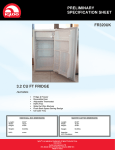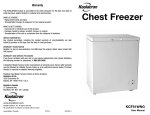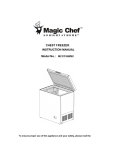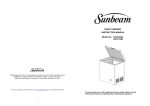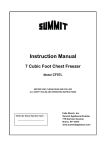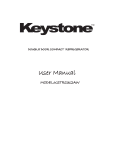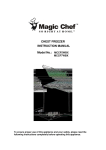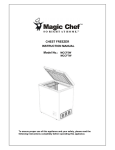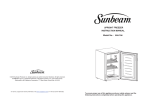Download Igloo FR320UK User's Manual
Transcript
Refrigerator Owner’s Manual Model FR320UK Printed in China Important Safety Instruction READ ALL INSTRUCTIONS BEFORE USING THE APPLIANCE. GROUNDING INSTRUCTIONS This appliance must be grounded. In the event of an electrical short circuit, grounding reduces the risk of electrical shock by providing an escape wire for the electrical current. This appliance is equipped with a cord that has a grounding plug built in. The plug must be plugged into an outlet that is properly installed and grounded. WARNING: IMPROPER USE OF GROUNDING PLUG CAN RESULT IN A RISK OF ELECTIC SHOCK. Consult a qualified electrician if the grounding instructions are not completely understood, or if the plug is not properly grounded. WARNING Danger or Warning: Risk of child entrapment. Child entrapment and suffocation are not problems of the past. Junked or abandoned appliances are still dangerous… even if they will “just sit in the garage for a few days.” Before you throw away your old refrigerator or freezer, take off the doors. Leave the shelves in place so that children may not easily climb inside Never allow children to operate, play with, or crawl inside the appliance. Never clean appliance parts with flammable fluids. The fumes can create a fire hazard or explosion. Do not store or use gasoline or any other flammable vapours and liquids in the vicinity of this or any other appliance. The fumes can create a fire hazard or explosion. INSTALLATION INSTRUCTIONS Before Using Your Appliance, remove the exterior and interior packing. Wipe the outside with a soft dry cloth and the inside with a wet lukewarm cloth. Check to be sure you have all of the following parts: ·Water Collection Tray ·Ice Cube Container IMPORTANT: Before connecting the appliance to the power source, let it stand upright for approximately 2 hours. This will reduce the possibility of a malfunction in the cooling system from handling during transportation. -- Save these instructions -- Installation of Your Appliance Place your appliance on a floor that is strong enough to support the appliance when it is fully loaded. To level your appliance, adjust the legs at the front of the appliance. NOTE: TO AVOID VIBRATION, THE APPLIANCE MUST BE LEVEL Allow 5 inches of space between the back and side of the appliance, which allows the proper air circulation to cool the compressor. Locate the appliance away from direct sunlight and sources of heat (stove, heater, radiator, etc.) Avoid locating the appliance in moist areas. Too much moisture in the air will cause frost to form quickly on the evaporator requiring more frequent defrosting of the appliance. Plug the appliance into an exclusive properly installed – grounded wall outlet. Do not, under any circumstances, cut or remove the third (ground) prong from the power cord. Any questions concerning power and/or grounding should be directed toward a certified electrician or an authorized service center. To reduce the risk of fire, electrical shock, or injury when using your appliance, follow these basic precautions. IDENTIFICATION DIAGRAM Temperature control Ice box Drip tray wire shelves Balcony shelves Glass shelf vegetable crisper Bottle rack Electrical Connection WARNING Improper use of the grounded plug can result in the risk of electrical shock. If the power cord is damaged, have it replaced by an authorized service center. This appliance should be properly grounded for your safety. The power cord of this appliance is equipped with a three-prong plug which mates with standard three prong wall outlets to minimize the possibility of electrical shock. Do not under any circumstances cut or remove the third ground prong from the power cord supplied. Use of extension cords is not recommended. This appliance requires a standard 230 volt, 50Hz electrical outlet with three-prong ground. The cord should be secured behind the appliance and not left exposed or dangling to prevent accidental injury. Reversing the Door Swing of your Appliance This appliance has the capability of either opening the door from the left or right side. The unit is delivered to you with the door opening from the left side. Should you need to reverse the opening direction, please follow the instructions pertaining to your particular model. NOTE: All parts removed must be saved to do the reinstallation of the door. For models FR320UK 1. Remove door plate screws from the underside of the fridge, on the right side. 2. Unscrew and remove the left foot. 3. Unscrew the door plate from fridge 4. Remove the 2 Phillips screws which connect the upper hinge to the cabinet top. 5. Carefully lift the door, placing it on a padded surface to avoid scratching. 6. Set the refrigerator door in its new position, making sure the hinge pin enters the bushing at the bottom of the cabinet. 7. While holding the door in the closed position, loosely secure the upper hinge using the parts removed in Step 4. Before tightening the screws, make sure the top of the door is level with the cabinet top. 8. Secure (front plate, if applicable) and bottom plate with the screws. 9. Switch left foot to the right side and secure. 1 2 HINGE COVER HINGE HINGE PIVOT PIN DOOR 3 BOTTOM FOOT OPERATING YOUR APPLIANCE Temperature Control Your appliance has only one control for regulating the temperature in the fresh food and the freezer compartment. The temperature control is located on the upper right hand side of the fresh food section. The first time you turn the unit on set the temperature control to “6” or the high position. The range of the temperature control is from position “1” the warmest to “6” the coldest. After 24 to 48 hours, adjust the temperature control to the setting that best suits your needs. The setting of “4” should be correct for home or office appliance use. To turn the appliance off, turn the temperature control to “OFF” NOTE: Turning the temperature control to “OFF” position stops the cooling cycle but does not shut off the power to the appliance. If the unit is unplugged, power lost, or turned off; you must wait 3 to 5 minutes before restarting the unit. If you attempt to restart before this time delay, the appliance will not start. Defrosting Your Appliance When? For the most efficient operation and minimum energy consumption, defrost the appliance compartment when the frost in the appliance walls is excessive or 1/4 inch thick. How? Remove the food from the appliance and place it in a cooler to protect the food. During the defrost cycle, the ice melts into the water collection tray. The water must be removed from the water collection tray as needed, to avoid overflow. To remove the water, either remove the water collection tray and/or place a collection container under the tray. Dry the water collection tray and place back under the appliance compartment. For those models with a self contained freezer compartment and no collection tray, water should be removed regularly during defrost, with a sponge. CAUTION Do not use boiling water because it may damage the plastic parts. In addition, never use a sharp or metallic instrument to remove frost as it may damage the cooling coils and will void the warranty. We recommend using a plastic scraper. Using Your Ice Cube Trays Recommended thermostat setting for ice making is between position 4 and maximum. Fill the ice cube tray (two thirds of it) with cold water or with any liquid suitable for freezing and place the tray on the bottom of the freezer to freeze properly. Dry the bottom of the tray, otherwise it may stick to the bottom of the freezer. The best method to get ice cubes out of the tray is to hold the tray under cold tap water for a second. To eject the ice cubes from the trays, place over the ice bucket and twist slightly. The Chiller Compartment (Model FR320UK) This compartment is designed for production of ice cubes and short term storage (3-4 days at most) of some commercially frozen foods. The temperature in this compartment may not get cold enough to safely freeze food for long periods of time and works best when the food is already frozen. By design, this chiller compartment is not a true freezer, and may not keep ice cream frozen, or freeze items. A colder setting may be used for these items, but other items in the refrigerator may also be affected. The chiller door is susceptible to breaking due to excessive ice build up. This part is not covered under your warranty. Be sure to defrost when the ice reaches 1/4 inch thick. CARE AND MAINTENANCE Cleaning Your Appliance Turn the temperature control to “OFF”, unplug the appliance, and remove the food, shelves, and trays. Wash the inside with a water and baking soda solution. The solution should be about 2 tablespoons of baking soda to a quart of water. Wash the shelves and trays with a mild detergent solution. The outside of the appliance should be cleaned with mild detergent and warm water. Maintenance of Your Appliance Power Failure Most power failures are corrected within a few hours and should not affect the temperature of your appliance if you minimize the number of times the door is opened. If the power is going to be off for a longer period of time, you need to take the proper steps to protect your food. Vacation Time During long absences, remove all the food; unplug your appliance, clean your appliance, and leave the door open slightly to avoid possible formation of condensation, mold, or odors. Moving Your Appliance Remove all the food. Securely tape down all loose items inside your appliance. Turn the leveling screws up to the base to avoid damage. Tape the door shut. Be sure the appliance stays in the upright position during transportation. Energy Saving Tips The appliance should be located in the coolest area of the room, away from heat producing appliances or heating ducts, and out of the direct sunlight. Let hot foods cool to room temperature before placing in the appliance. Overloading the appliance forces the compressor to run longer. Foods that freeze too slowly may lose quality, or spoil. Be sure to wrap foods properly, and wipe containers dry before placing them in the appliance. This cuts down on frost buildup inside the appliance. Appliance storage bin should not be lined with aluminum foil, wax paper, or paper toweling. Liners interfere with cold air circulation, making the appliance less efficient. Organize and label food to reduce door openings and extended searches. Remove as many items as needed at one time, and close the door as soon as possible. PROBLEMS WITH YOUR APPLIANCE You can solve many common appliance problems easily, saving you the cost of a possible service call. Try the suggestions below to see if you can solve the problem before calling for service. TROUBLESHOOTING GUIDE PROBLEM POSSIBLE CAUSE Appliance does not operate. Not plugged in. The circuit breaker tripped or blown fuse. The appliance temperature control is set at “OFF”. Compressor turns on and off The room temperature is hotter than normal. frequently. A large amount of food has been added to the appliance. The door is open too often. The door is not closed completely. The temperature control is not set correctly. The door gasket does not seal properly. The appliance does not have the correct clearance. Vibrations Check to ensure that the appliance is level. The appliance seems to make too The rattling noise may come from the flow of the refrigerant, much noise. which is normal. As each cycle ends, you may hear gurgling sounds caused by the flow of refrigerant in your appliance. Contraction and expansion of the inside walls may cause popping and crackling noises. The door will not close properly. The appliance is not level. The door was reversed and not properly installed. The gasket is dirty. The shelves, bins, or baskets are out of position.








